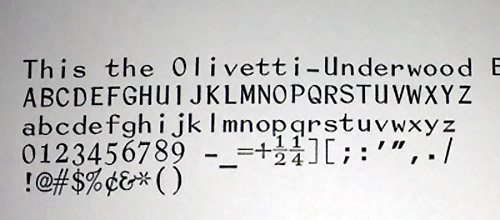
My attention was caught a couple of years ago by this Olivetti-Underwood Editor 2 (#E13-6003749, formerly in the Brumfield collection), as pictured on The Typewriter Database. Its beautiful typeface is Elite Correspondence Gothic, according to the 1964 NOMDA Blue Book.

It wasn't just the typeface that attracted me, but the stylish curves of the typewriter. Designer George Nelson had the honor of having the Editor 2 included in the collection of the Museum of Modern Art.

Nelson looks pleased:

Nelson also designed typewriters for Royal in the '60s. Here you can see what I believe is a prototype design for a Royal electric. Nelson's protege John Svezia also designed a machine for Olivetti: see the story on Robert Messenger's OzTypewriter.
The Editor 2 is not a common machine. I can find only a few other examples online:




| Tekne 5 (Editor) | |||||
| 6000351 | 1965 | ||||
| 6000870 | 1966 | ||||
| 6010785 | 1967 | ||||
| 6017973 | 1968 | ||||
| 6030000 | 1969 | ||||
| 6038000 | 1970 | ||||
| 6051000 | 1971 |
If that's right, then the ex-Brumfield machine that originally caught my eye, #E13-6003749, would date from 1966. The last machine shown above, spotted by Brian Brumfield in the wild, is #E13-6043025 (1970).
I note that production was very low in the first couple of years, and then sped up a bit. If some 50,000 machines were made, you'd think they would be more common. Maybe many of the typewriters in this sequence are Teknes rather than Editors. The Teknes and later Editors have boxy designs that are no match for the attractive lines of the Editor 2. (See Tekne 3, Editor 3, and Editor 4 on TWDB.)
As far as I know, all these Olivetti electrics use a system in which depressing a key brings down a hook (X in the diagram below) that catches on a bail (36). The bail then flips up and activates the typebar. What's particularly clever is that a mechanism prevents two typebars from being activated simultaneously; if you press down two keys at once, the keyboard becomes inoperative. Backspacing releases the mechanism and lets you type again.

The diagram above comes from a service manual for the Praxis 48 that you can download here for $6.99, thanks to Ted Munk. The Praxis 48 is the most readily available Olivetti electric of this type. (Image from Museo Tecnologicamente.) In contrast to the Tekne and Editor, the Praxis 48 is a modest-sized typewriter, primarily for home use rather than heavy-duty office use. It's a very enjoyable typewriter when it's working, but it has a reputation for being very challenging to repair.

Anyway ... three or four years ago I saved a search for an Editor 2 on eBay, and finally I was rewarded with a hit. But the seller said that it wasn't working. I was scared off. However, after it was listed several times and finally offered for a Buy It Now price of $8.99, I couldn't resist. Soon it was sitting on my desk.

This machine uses a carbon ribbon, so you can discover what's been typed on it. I had a sort of "Shining" moment when I read: "Now is the time for all good men to come to the aid of their country. Now is the time for all good men to come to the aid of their country. Now is the time for all good men to come to the aid of their country. Now is the time for all good men to come to the aid of their country. ..." But some older text before this seems to be ordinary business correspondence. If I find anything exciting, I'll let you know!
The shell comes off very easily, and I was able to clean and degrease the typewriter, which helped a lot.

But the carriage return was too feeble. With advice from Australian master mechanic John Lavery, I realized that the wheel that pulls the cord attached to the carriage (in the center of the photo below) needed more friction to connect it to a spinning disk against which the wheel is pushed when you hit the carriage return key. My clever (I hope) solution was to tape a circle of duct tape over the disk. So far, it's working well.

Along the way to this solution, though, I clumsily popped out the spring that winds up the cord.



Oops. That took a while to correct.
But this was not the most frustrating problem. Some keys just weren't working at all, and I figured out that some small springs had gotten disconnected. (See the red spring in the diagram from the service manual above.) But how was I supposed to get them back in? They were deep in the dark woods.



The problem was getting enough light, maneuvering in a tight space, and simply learning to see what was going on, when only small portions of the mechanism could be glimpsed at a time.
Finally I realized that the best approach was to come in from the top, gripping the spring with a hemostat, fumble around half-blind until the bottom of the spring connected, then connect the top.
\


Hours and days and many swear words later, the job was done. It is one of the hardest operations I've performed on a typewriter.
So, does the machine finally work?

Mystery: when was this typewriter made? The serial number is far above #6051000, the number listed for the beginning of 1971, and no further years are listed. Maybe I haven't found the corrrect serial number sequence, and maybe our data is partial or incorrect.




